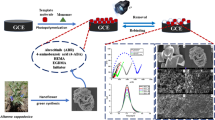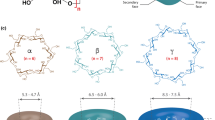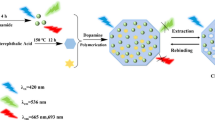Abstract
Molecularly imprinted polymers on the surface of multiwalled carbon nanotubes (MWNTs) have been developed for selective recognition for Ribavirin. The composites (MWNTs/MIPs) were prepared by using Ribavirin as the template molecule, acrylamide (AAM) as the functional monomer, N, N-methylenebisacrylamide (NNMBA) as the cross-linker. MWNTs/MIPs obtained were characterized by fourier transform infrared spectroscopy (FTIR), scanning electron microscopy (SEM), and thermogravimetric analysis (TGA). The properties such as adsorption dynamics, special binding, and the selective recognition ability were evaluated. The adsorption equilibrium was arrived in about 4 h which indicated that the adsorption kinetic was comparatively fast. The results of binding and selectivity experiments showed that the MWNTs/MIPs could bind the template molecule selectively in aqueous media.









Similar content being viewed by others
References
Yang Y, Long YY, Cao Q, Li K, Liu F (2008) Molecularly imprinted polymer using β-cyclodextrin as functional monomer for the efficient recognition of bilirubin. Anal Chim Acta 606:92–97
Mazzotta E, Malitesta C (2010) Electrochemical detection of the toxic organohalide 2,4-DB using a Co-porphyrin based electrosynthesized molecularly imprinted polymer. Sens Actuators B 148:186–194
Amut E, Fu Q, Fang Q, Liu R, Xiao AP, Zeng AG, Chang C (2010) In situ polymerization preparation of chiral molecular imprinting polymers monolithic column for amlodipine and its recognition properties study. J Polym Res 17:401–409
Kubo T, Nomachi M, Nemoto K, Sano T, Hosoya K, Tanaka N, Kaya K (2006) Chromatographic separation for domoic acid using a fragment imprinted polymer. Anal Chim Acta 577:1–7
Beltran A, Marce RM, Cormack PAG, Borrull F (2010) Synthetic approaches to parabens molecularly imprinted polymers and their applications to the solid-phase extraction of river water samples. Anal Chim Acta 677:72–78
Han DM, Fang GZ, Yan XP (2005) Preparation and evaluation of a molecularly imprinted sol–gel material for on-line solid-phase extraction coupled with high performance liquid chromatography for the determination of trace pentachlorophenol in water samples. J Chromatogr A 1100:131–136
Zhang ZH, Yang X, Zhang HB, Zhang ML, Luo LJ, Hu YF, Yao SZ (2011) Novel molecularly imprinted polymers based on multi-walled carbon nanotubes with binary functional monomer for the solid-phase extraction of erythromycin from chicken muscle. J Chromatogr B 879:1617–1624
Shen ZL, Yuan D, Su QD, Zhang H, Wang J, Zhu JH, Liu YM (2011) Selective solid-phase extraction using molecularly imprinted polymer for analysis of methamidophos in water and soil samples. Biosci Biotechnol Biochem 75:473–479
Kriz D, Mosbach K (1995) Competitive amperometric morphine sensor based on an agarose immobilised molecularly imprinted polymer. Anal Chim Acta 300:71–75
Andrea P, Miroslav S, Silvia S, Stanislav M (2001) A solid binding matrix/molecularly imprinted polymer-based sensor system for the determination of clenbuterol in bovine liver using differential-pulse voltammetry. Sens Actuators B 76:286–294
Kröger S, Turner APF, Mosbach K, Haupt K (1999) Imprinted polymer-based sensor system for herbicides using differential-pulse voltammetry on screen-printed electrodes. Anal Chem 71:3698–3702
Wulff G (2002) Enzyme-like catalysis by molecularly imprinted polymers. Chem Rev 102:1–28
Ramström O, Mosbach K (1999) Synthesis and catalysis by molecularly imprinted materials. Curr Opin Chem Biol 3:759–764
Gholivand MB, Khodadadian M (2011) Rationally designed molecularly imprinted polymers for selective extraction of methocarbamol from human plasma. Talanta 85:1680–1688
Sambe H, Hoshina K, Haginaka J (2007) Molecularly imprinted polymers for triazine herbicides prepared by multi-step swelling and polymerization method. Their application to the determination of methylthiotriazine herbicides in river water. J Chromatogr A 1152:130–137
Xu ZF, Xu L, Kuang DZ, Zhang FX, Wang JQ (2008) Exploiting β-cyclodextrin as functional monomer in molecular imprinting for achieving recognition in aqueous media. Mater Sci Eng C 28:1516–1521
Iijima S (1991) Helical microtubules of graphitic carbon. Nature 354:56–58
Tsai FC, Shu CM, Tsai LC, Ma N, Wen Y, Wen S, Yang YK, Zhou W, Xiao HW, Shu YC , Jiang T. Chapter 7: Carbon nanotube industrial applications, In: Jose Mauricio Marulanda (Ed.) Carbon nanotubes applications on electron devices, ISBN: 9789533074962, InTech, Aug 2011, pp. 387–404.
Kan XW, Zhao Y, Geng ZR, Wang ZL, Zhu JJ (2008) Composites of multiwalled carbon nanotubes and molecularly imprinted polymers for dopamine recognition. J Phys Chem 112:4849–4854
Lee SC, Chuang FL, Tsai YL, Chen H (2010) Studies on the preparation and properties of sol-gel molecularly imprinted polymer based on tetraethoxysilane for recognizing sulfonamides. J Polym Res 17:737–744
Acknowledgments
This study was partially supported by the National Natural Science Foundation of China (No.20202015) and the Key Academic Program of 211 Project of South China Agricultural University (2009B010100001). The support by the large-scale scientific instrumentation foundation of South China Agricultural University was also acknowledged.
Author information
Authors and Affiliations
Corresponding author
Rights and permissions
About this article
Cite this article
Xu, L., Xu, Zf. Molecularly imprinted polymer based on multiwalled carbon nanotubes for ribavirin recognition. J Polym Res 19, 9942 (2012). https://doi.org/10.1007/s10965-012-9942-1
Received:
Accepted:
Published:
DOI: https://doi.org/10.1007/s10965-012-9942-1




